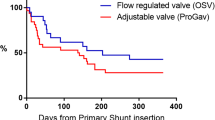Abstract
The choice of shunt valve in the treatment of hydrocephalus in children remains controversial. We embarked on a pilot study to determine the differences in outcome between differential-pressure and flow-regulating valves. Prospective data collected on 50 consecutive first-time shunt insertions, performed between June 1993 to June 1996, was analysed. Children with tumour- related hydrocephalus and Dandy-Walker malformations as well as children who had external ventricular drainage prior to definitive shunt insertion were excluded from the study. The defining event was the first complication necessitating surgery, including obstruction, over-drainage and infection. Of the 50 children (31 males), 23 had differential pressure (medium-pressure) and 27 had Delta (performance level 2) valves inserted. The mean age at shunt insertion was 26.4 months. The mean follow-up was 53.8 months. The overall cumulative shunt survival at 5 years was 58.6% for the differential pressure and 58.7% for the Delta valves. The mean shunt life was 37.1 months for the differential pressure group and 34.6 months for the Delta group. This difference was not statistically significant (P=0.72, t-test). Both valves had a similar outcome with respect to obstruction (including proximal, valve, distal). The main differences between the two valves were with respect to the incidence of over-drainage and infection. Amongst the differential pressure valves, there were 4 instances of overdrainage (3 slit-ventricle syndrome, 1 bilateral subdural collection) – all occurring within the first 36 months. The Delta valve group had only one instance of over-drainage (bilateral subdural collection). There were no infections in the differential pressure valve group, whereas 3 of the Delta valve shunts got infected, all within the first month. Whereas both shunt types seemed to have a similar overall survival, there was a relatively higher incidence of over-drainage amongst the differential pressure valves. The Delta valves, on the other hand, had higher rates of infection. Similar studies with larger numbers could suggest whether the choice of shunt type will ultimately have to be a compromise accepting one or the other complication.
Similar content being viewed by others
Author information
Authors and Affiliations
Additional information
Received: 12 October 1999
Rights and permissions
About this article
Cite this article
Jain, H., Sgouros, S., Walsh, A. et al. The treatment of infantile hydrocephalus: ”differential-pressure” or ”flow-control” valves . Child's Nerv Syst 16, 242–246 (2000). https://doi.org/10.1007/s003810050505
Issue Date:
DOI: https://doi.org/10.1007/s003810050505




